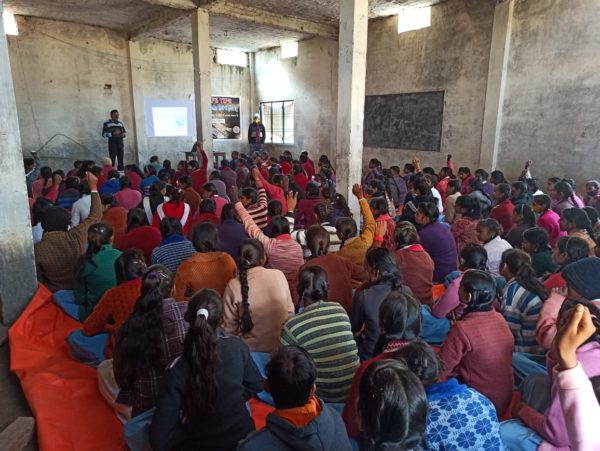What does slavery look like? Somehow it’s both notorious and faceless.
Sometimes it peeks out from bars or restaurants. Often it’s hidden in homes, brothels, and farms, then buried further in international supply chains.
Child slaves—forced to haul heavy bricks at kilns in India and stones weighing as much as they do at rock quarries in Nepal, forced to mine gold and diamonds, and minerals that run our cell phone batteries, while covered in toxic dust—suffer in silence, sight unseen.
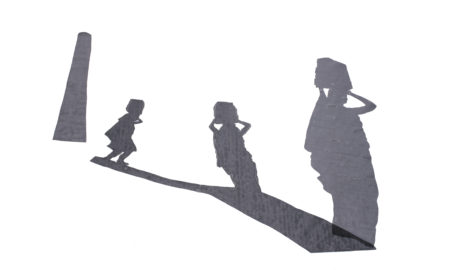 Slaves in Brazil, making the black oily charcoal used to run smelters that make steel for our cars, are all but invisible. Slaves may pick the tomatoes or catch the tuna that fill grocery stores around the world. By the time slavery arrives as fruit in our produce sections, shrimp at our fish counters, and coffee in our cups, slaves have been completely disappeared. But no matter how obscured or forgotten, slavery is global—it travels, and it exists as suffering.
Slaves in Brazil, making the black oily charcoal used to run smelters that make steel for our cars, are all but invisible. Slaves may pick the tomatoes or catch the tuna that fill grocery stores around the world. By the time slavery arrives as fruit in our produce sections, shrimp at our fish counters, and coffee in our cups, slaves have been completely disappeared. But no matter how obscured or forgotten, slavery is global—it travels, and it exists as suffering.
Artist Sandra Relyea has found a powerful, thoughtful way to bring slavery out of the shadows. Her latest exhibit comprises large works of clever silhouettes that play on the use of light and shadows themselves. Her shadow-shaped figures are meant to represent real people enslaved in the world today. The images, she explains, are “distorted and elongated the way a shadow cast by the real person would be.” Many pieces in the collection are based on photographs and films from Free the Slaves.
Relyea’s point is to show slavery exists everywhere in the world, including the United States, but, she says, “it is largely unseen and lies in the world of shadow: the world of exploitation, crime, and dehumanization.” Her images are evocative in their simplicity and staggering in their force. Each work can take up an entire wall, up to eight feet wide and 12 feet high.
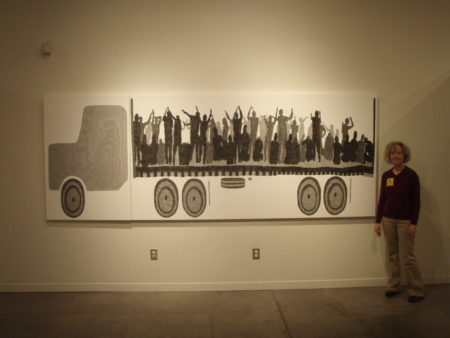
Artist Sandra Relyea with one of her swhadow slavery artworks
The pieces loom yet remain calmly distant: slavery as both stark and shrouded. They are aggressive in their magnitude, and sense of action and movement—they demand you look. Yet they are also quiet and cool, restrained, reticent. The contrast of darkness and light—people defined by outlines yet disguised and indistinguishable—speaks of bondage and liberation both.
A striking, significant piece shows child slaves in Ghana fishing in a rickety boat, tossed on thick, vast waves. Relyea found it difficult at first to depict a shadow falling on water, but the final version is haunting in how much it seems to waver and pitch. “The ripples in the water signify the fact that these children are in peril,” she says. “They do not know how to swim.”
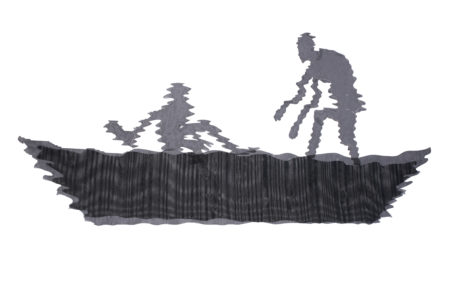 In a piece with special significance to Relyea, two Nepalese children with stones strapped to their backs appear as little more than two tiny, fragile blocks, yet they are clearly holding hands. “The holding hands,” she says, “suggests to me the potential that lies in all children, which is denied them when they are not free.”
In a piece with special significance to Relyea, two Nepalese children with stones strapped to their backs appear as little more than two tiny, fragile blocks, yet they are clearly holding hands. “The holding hands,” she says, “suggests to me the potential that lies in all children, which is denied them when they are not free.”
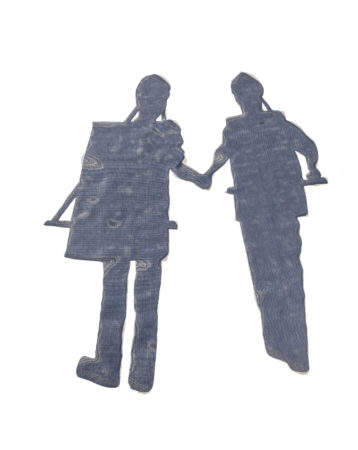 For more than two decades, Relyea was as a forensic child abuse examiner and often testified as an expert medical witness. As a physician’s assistant in Redding, Calif., where she has lived for more than 25 years, she has helped deliver health services, often from a mobile van, to local homeless, uninsured, and underserved people, many of them children. A long-time advocate for society’s exploited, underprivileged, and disenfranchised, Relyea draws motivation from the act of eliminating injustice.
For more than two decades, Relyea was as a forensic child abuse examiner and often testified as an expert medical witness. As a physician’s assistant in Redding, Calif., where she has lived for more than 25 years, she has helped deliver health services, often from a mobile van, to local homeless, uninsured, and underserved people, many of them children. A long-time advocate for society’s exploited, underprivileged, and disenfranchised, Relyea draws motivation from the act of eliminating injustice.
Several years ago Relyea took an art class at a local college “just for fun”—she ended up discovering the perfect link between her professional advocacy work, which she describes as “cerebral and mostly left-brained,” and the strong font of personal creativity she needed to let flow.
One day she created a work of shadows with a window screen. “It occurred to me issues such as homelessness could be depicted with shadow forms,” Relyea says. She later realized the subject of modern slavery also lent itself perfectly to shadow works. She discovered the work of Free the Slaves when she began researching modern slavery in general, and how it could inform her art.
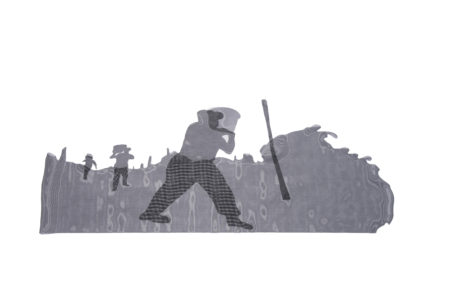 Relyea named her latest shadow collection Demeter’s Children. In the Greek myth, Demeter’s daughter is kidnapped and held in bondage in the underworld, trapping the globe in desolate winter. Relyea intends her slaves-as-shadows portraits to increase public awareness and understanding of human trafficking and slavery.
Relyea named her latest shadow collection Demeter’s Children. In the Greek myth, Demeter’s daughter is kidnapped and held in bondage in the underworld, trapping the globe in desolate winter. Relyea intends her slaves-as-shadows portraits to increase public awareness and understanding of human trafficking and slavery.
The human shadow is a guiding philosophical concept, developed by Carl Jung, for Relyea. Jung’s theory goes that individuals have traits and tendencies that cause discomfort, vulnerability, and are therefore relegated to the subconscious where they can be denied or ignored. “We tend to project these shadow characteristics onto others, and [judge them] as wrong, undesirable,” Relyea explains. “This can lead to dislike, condemnation, blame, and even persecution.”
The artist believes slavery is, in a way, the disastrous manifestation of the shadows—the dark side—of humanity’s collective unconscious. Her work explores how slavery can arise from the repression of our own shadow selves, and be borne out in, and portrayed as, the brute oppression of others. The spectral figures in Demeter’s Children emerge to connect slavery to the world, to what we look at, and to ourselves. Even in shadows, Relyea’s work gives us slaves we can see.
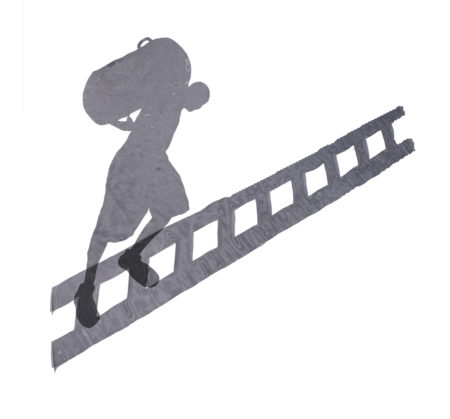 Demeter’s Children will open in October 2018 in the galleries of the Turtle Bay Exporation Park in Redding, California.
Demeter’s Children will open in October 2018 in the galleries of the Turtle Bay Exporation Park in Redding, California.
Photos of the artworks by Diana Vader.

